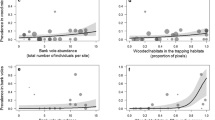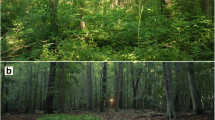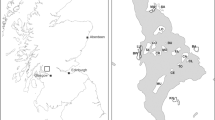Abstract
Context
Tick-borne diseases are becoming increasingly prevalent world-wide. This is likely due in part to land-cover change, particularly forest fragmentation, but this evidence is largely limited to Lyme disease. It is unknown whether this is generalizable to other, emergent tick-borne pathogens.
Objectives
Motivated by hypotheses regarding landscape context and vertebrate hosts, we asked how landscape context, namely habitat amount, quality, and fragmentation, is related to the distribution of Ehrlichia chaffeensis, a tick-borne pathogen of increasing concern, and the interannual occupancy dynamics of its vector, the lone star tick (Amblyomma americanum).
Methods
We collected nymphal ticks from 130 plots in southeastern Virginia, U.S., for 5 years and tested for E. chaffeensis via targeted PCR. We derived metrics of landscape context from Landsat data and related these to pathogen prevalence and tick turnover using hierarchical Bayesian models.
Results
Landscape context was associated with both pathogen prevalence and tick turnover. Pathogen prevalence was negatively associated with total forest landcover, coniferous forest landcover, and forest edge density. Tick turnover was positively associated with coniferous landcover and with an interaction between total forest landcover and edge. This interaction was such that turnover was predicted to be lowest in small contiguous forests, and highest in small fragmented forests.
Conclusions
Landscape context affects E. chaffeensis prevalence and occupancy dynamics of its tick host, though these processes appear decoupled. We hypothesize that pathogen prevalence may be more driven by reservoir host movement and social behavior and tick dynamics are more driven by host population density.





Similar content being viewed by others
Data availability
Data and code to run these analyses are available online at https://github.com/dylantuxsimpson/EC-SDMs.
References
Allan BF, Goessling LS, Storch GA, Thach RE (2010) Blood meal analysis to identify reservoir hosts for Amblyomma americanum ticks. Emerg Infect Dis 16:433–440
Allan BF, Keesing F, Ostfeld R (2003) Effect of forest fragmentation on Lyme disease risk. Conserv Biol 17:267–272
Anderson BE, Sims KG, Olson JG, Childs JE, Piesman JF, Happ CM, Maupin GO, Johnson BJB (1993) Amblyomma americanum: a potential vector of human ehrlichiosis. Am J Trop Med Hyg 49:239–244
Beasley JC, Devault TL, Rhodes OEJ (2007) Home-range attributes of raccoons in a fragmented agricultural region of northern Indiana. J Wildl Manage 71:844–850
Berger BW (1989) Dermatologic manifestations of lyme disease. Rev Infect Dis 11:S1475–S1481
Beyer HL (2014) Geospatial Modeling Environment. http://www.spatialecology.com/gme
Bishopp FC, Trembley HL (1945) Distribution and hosts of certain North American ticks. J Parasitol 31:1–54
Brownstein JS, Skelly DK, Holford TR, Fish D (2005) Forest fragmentation predicts local scale heterogeneity of Lyme disease risk. Oecologia 146:469–475
Campbell TA, Laseter BR, Ford WM, Miller KV (2004) Feasibility of localized management to control white-tailed deer in forest regeneration areas. Wildl Soc Bull 32:1124–1131
Cornicelli L, Woolf A, Roseberry JL (1996) White-tailed deer use of a suburban environment in southern Illinois. Trans Illinois State Acad Sci 89:93–103
Côté IM, Gross MR (1993) Reduced disease in offspring: a benefit of coloniality in sunfish. Behav Ecol Sociobiol 33:269–274
Davidson WR, Lockhart JM, Stallknecht DE, Howerth EW, Dawson JE, Rechav Y (2001) Persistent Ehrlichia chaffeensis infection in white-tailed deer. J Wildl Dis 37:538–546
de Sá-Hungaro IJB, de Almeida Raia V, da Costa Pinheiro M, Ribeiro CCDU, Famadas KM (2014) Amblyomma auricularium (Acari: Ixodidae): underwater survival of the non-parasitic phase of feeding females. Braz J Vet Parasitol 23:387–392
Estrada-Peña A, Vatansever Z, Gargili A, Ergönul Ö (2010) The trend towards habitat fragmentation is the key factor driving the spread of Crimean-Congo haemorrhagic fever. Epidemiol Infect 138:1194–1203
Gaff H, Schaefer E (2010) Disease transmission modelling. In: Michael E, Spear RC (eds) Modeling parasite transmission and control. Lands Bioscience and Springer, New York, pp 51–65
Gaughan CR, DeStefano S (2005) Movement patterns of rural and suburban white-tailed deer in Massachusetts. Urban Ecosyst 8:191–202
Ginsberg HS, Ewing CP (1989) Comparison of flagging, walking, and collecting from hosts as sampling methods for northern deer ticks, Ixodes dammini and lone-star ticks, Amblyomma americanum (Acari: Ixodidae). Exp Appl Acarol 7:313–322
Glueck TF, Clark WR, Andrews RD (1988) Raccoon movement and habitat use during the fur harvest season. Wildl Soc Bull 16:6–11
Habib TJ, Merrill EH, Pybus MJ, Coltman DW (2011) Modelling landscape effects on density-contact rate relationships of deer in eastern Alberta: implications for chronic wasting disease. Ecol Modell 222:2722–2732
Hasapes SK, Comer CE (2016) Adult white-tailed deer seasonal home range and habitat composition in Northwest Louisiana. J Southeast Assoc Fish Wildl Agencies 3:243–252
Heitman N, Scott Dahlgren F, Drexler NA, Massung RF, Behravesh CB (2016) Increasing incidence of ehrlichiosis in the United States: a summary of national surveillance of Ehrlichia chaffeensis and Ehrlichia ewingii infections in the United States, 2008–2012. Am J Trop Med Hyg 94:52–60
Hölzenbein S, Marchinton RL (1992) Integration of maturing-male white-tailed deer into the adult population. J Mammal 73:326–334
Kilpatrick HJ, Labonte AM, Stafford KC (2014) The relationship between deer density, tick abundance, and human cases of lyme desease in a residential community. J Med Entomol 51:777–784
Kollars TMJ, Oliver JHJ, Durden LA, Kollars PG (2000) Host associations and seasonal activity of Amblyomma americanum (Acari: Ixodidae) in Missouri. J Parasitol 86:1156–1159
Liu Y, Lund RB, Nordone SK, Yabsley MJ, McMahan CS (2017) A Bayesian spatio-temporal model for forecasting the prevalence of antibodies to Ehrlichia species in domestic dogs within the contiguous United States. Parasit Vectors 10:138
Lovely KR, McShea WJ, Lafon NW, Carr DE (2013) Land parcelization and deer population densities in a rural county of Virginia. Wildl Soc Bull 37:360–367
Mackenzie DI, Hines JE (2016) PRESENCE. https://www.usgs.gov/software/presence
MacKenzie DI, Nichols JD, Hines JE, Knutson MG, Franklin AB (2003) Estimating site occupancy, colonization, and local extinction when a species is detected imperfectly. Ecology 84:2200–2207
Manangan JS, Schweitzer SH, Nibbelink N, Yabsley MJ, Gibbs SEJ, Wimberly MC (2007) Habitat factors influencing distributions of Anaplasma phagocytophilum and Ehrlichia chaffeensis in the Mississippi Alluvial Valley. Vector-Borne Zoonotic Dis 7:563–574
McGarigal K (2015) FRAGSTATS HELP v4. University of Massachusetts, Amherst. https://www.umass.edu/landeco/research/fragstats/documents/fragstats.help.4.2.pdf
McGarigal K, Cushman SA, Ene E (2012) Fragstats v.4: spatial pattern analysis program for categorical and continuous maps. University of Massachussets, Amherst. http://www.umass.edu/landeco/research/fragstats/fragstats.html
Mooring MS, Hart BL (1992) Animal grouping for protection from parasites: selfish herd and encounter-dilution effects. Behaviour 123:173–193
Nair ADS, Cheng C, Jaworski DC, Willard LH, Sanderson MW, Ganta RR (2014) Ehrlichia chaffeensis infection in the reservoir host (white-tailed deer) and in an incidental host (dog) is impacted by its prior growth in macrophage and tick cell environments. PLoS ONE. https://doi.org/10.1371/journal.pone.0109056
Oregon State University (2018) PRISM. In: Northwest Alliance Computer Science Engineering. www.prism.oregonstate.edu. Accessed 20 Apr 2018
Ostfeld RS, Jones C, Wolff J (1996) Of mice and mast: ecological connections in eastern deciduous forests. Bioscience 46:323–330
Ostfeld RS, Levi T, Keesing F, Oggenfuss K, Canham CD (2018) Tick-borne disease risk in a forest food web. Ecology 99:1562–1573
Plummer M (2017) JAGS: a program for analysis of Bayesian graphcial models using Gibbs sampling. http://mcmc-jags.sourceforge.net
R Core Team (2019) R: a language and environment for statistical computing. R Foundation for Statistical Computing, Vienna, Austria. https://www.R-project.org/
Rand PW, Lubelczyk C, Lavigne GR, Elias S, Holman MS, Lacombe EH, Smith RP Jr (2003) Deer density and the abundance of Ixodes scapularis (Acari: Ixodidae). J Med Entomol 40:179–184
Robinson SJ, Samuel MD, Lopez DL, Shelton P (2012) The walk is never random: subtle landscape effects shape gene flow in a continuous white-tailed deer population in the Midwestern United States. Mol Ecol 21:4190–4205
Rosatte R, Ryckman M, Ing K, Proceviat S, Allan M, Bruce L, Donovan D, Davies JC (2010) Density, movements, and survival of raccoons in Ontario, Canada: implications for disease spread and management. J Mammal 91:122–135
Rubenstein DI, Hohmann ME (1989) Parasites and social behavior of island feral horses. Oikos 55:312–320
Saïd S, Servanty S (2005) The influence of landscape structure on female roe deer home-range size. Landsc Ecol 20:1003–1012
Semtner PJ, Barker RW, Hair JA (1971) The ecology and behavior of the lone star tick (Acarina: Ixodidae). II. Activity and survival in different ecological habitats. J Med Entomol 8:719–725
Simpson DT, Teague MS, Weeks JK, Lewis AD, D'Addio PM, Moore JD, Thompson JA, Harris AC, Cannella RT, Kaup BZ, Kerscher O, Matthias L (2019) Broad, multi-year sampling effort highlights complex dynamics of the tick-borne pathogen Ehrlichia chaffeensis (Rickettsiales: Anaplasmatacae). J Med Entomol 56:162–168
Skuldt LH, Mathews NE, Oyer AM (2008) White-tailed deer movements in a chronic wasting disease area in South-Central Wisconsin. J Wildl Manage 72:1156–1160
Stanek G, Wormser GP, Gray J, Strle F (2012) Lyme borreliosis. Lancet 379:461–473
Stein KJ, Waterman M, Waldon JL (2008) The effects of vegetation density and habitat disturbance on the spatial distribution of ixodid ticks (Acari: Ixodidae). Geospat Health 2:241–252
Stuber EF, Gruber LF, Fontaine JJ (2017) A Bayesian method for assessing multi-scale species-habitat relationships. Landsc Ecol 32:2365–2381
Su Y-S, Yajima M (2015) R2jags: Using R to Run “JAGS”. R package version 0.5-7. https://CRAN.R-project.org/package=R2jags
U.S. Census Bureau (2011) Transportation geodatabase. In: TIGER Products. https://www.census.gov/cgi-bin/geo/shapefiles/index.php
Virginia Department of Game and Inland Fisheries (2015) White-tailed Deer Management Plan, 2015-2024. Richmond
Virginia Geographic Information Network (2011) Virginia LIDAR. In: Virginia GIS clearinghouse. https://vgin.maps.arcgis.com/home/index.html
Wimberly MC, Yabsley MJ, Baer AD, Dugan VG, Davidson WR (2008) Spatial heterogeneity of climate and land-cover constraints on distributions of tick-borne pathogens. Glob Ecol Biogeogr 17:189–202
Wright CL, Gaff HD, Hynes WL (2014) Prevalence of Ehrlichia chaffeensis and Ehrlichia ewingii in Amblyomma americanum and Dermacentor variabilis collected from southeastern Virginia, 2010-2011. Ticks Tick Borne Dis 5:978–982
Yabsley MJ (2010) Natural history of Ehrlichia chaffeensis: vertebrate hosts and tick vectors from the United States and evidence for endemic transmission in other countries. Vet Parasitol 167:136–148
Yabsley MJ, Dugan VG, Stallknecht DE, Little SE, Lockhart M, Dawson JE, Davidson WR (2003) Evaluation of a prototype Ehrlichia chaffeensis surveillance system using white-tailed deer (Odocoileus virginianus) as natural sentinels. Vector-borne zoonotic Dis 3:195–207
Acknowledgements
We thank Andrew Lewis, Julia Moore, Joseph Thompson, Alan Harris, Richard Cannella, Matt Feresten, Ann Marie Rydberg, Christopher Tyson, Stephanie Wilson, James Woods, and Nora Wicks for help collecting ticks. We thank Phillip D’Addio for his help with molecular analyses. We are grateful to the following landowners for providing access: Colonial National Historical Park, Colonial Williamsburg, Newport News Park, Waller Mill Park, Freedom Park, Greensprings Trail Park, York River State Park, Joint Base Langley-Eustis, and the Virginia State Department of Forestry. This work was supported by William & Mary’s Commonwealth Center for Energy and the Environment, Charles Center, and Environmental Science and Policy Program, and the Strategic Environmental Research and Development Program (RC-2202).
Author information
Authors and Affiliations
Corresponding author
Additional information
Publisher's Note
Springer Nature remains neutral with regard to jurisdictional claims in published maps and institutional affiliations.
Electronic supplementary material
Below is the link to the electronic supplementary material.
Rights and permissions
About this article
Cite this article
Simpson, D.T., Teague, M.S., Weeks, J.K. et al. Habitat amount, quality, and fragmentation associated with prevalence of the tick-borne pathogen Ehrlichia chaffeensis and occupancy dynamics of its vector, Amblyomma americanum. Landscape Ecol 34, 2435–2449 (2019). https://doi.org/10.1007/s10980-019-00898-5
Received:
Accepted:
Published:
Issue Date:
DOI: https://doi.org/10.1007/s10980-019-00898-5




